.jpeg)

.jpeg)
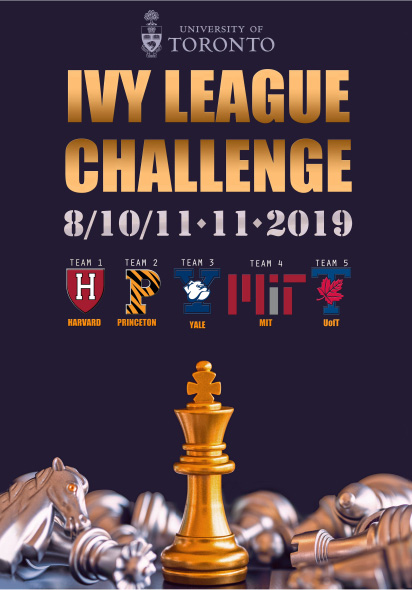
The inaugural Ivy League Chess Challenge was held last year, and the Hart House Chess Club at the University of Toronto is honoured to have successfully hosted the second one. This year’s tournament featured a round-robin between the Ivy League universities Harvard, Yale, Princeton, as well as MIT and two University of Toronto teams.
The Ivy League Chess Challenge is an ode to all the students out there who, despite having midterms, problem sets, projects and assignments that are due, are more than willing pursue a passion. It is very challenging to balance chess with studies, and many students have had to almost drop chess, if not completely, in order to succeed in their academics.
Some of the highest rated participants in the 2019 Ivy League Challenge included GM Andrew Tang (2507 – Princeton), IM Advait Patel (2460 – UofT A), FM Mark Plotkin (2378 – UofT A), FM Aaron Jacobson (2340 – Harvard), FM Ethan Li (2231 – Princeton) and WGM Qiyu Zhou (2212 – UofT A), among many other strong players.

(Left) The chief organizer, Panagiotis Tsialas gives the opening speech
(Right) Michelle Brownrigg, Senior Director of Co-Curricular Education & Chief Program Officer for Hart House | Photo: Skylar (Cheryl) Cheung
The first round started Friday morning, with Harvard facing Yale and MIT facing Princeton. We also saw the two University of Toronto teams going head-to-head.
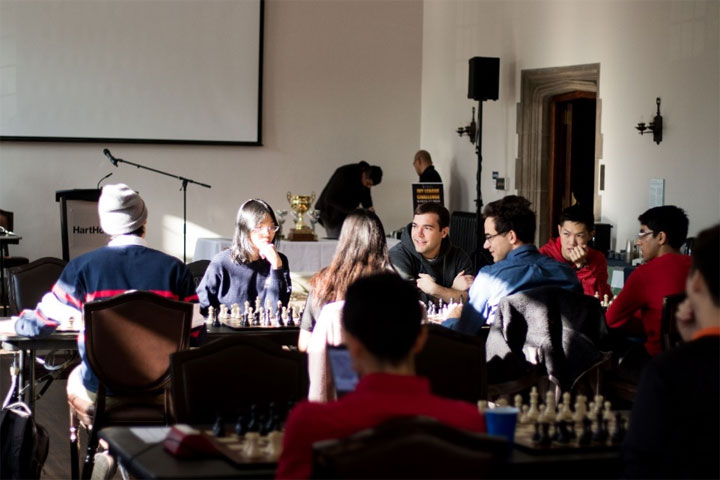
Spirits are high going into the first round!
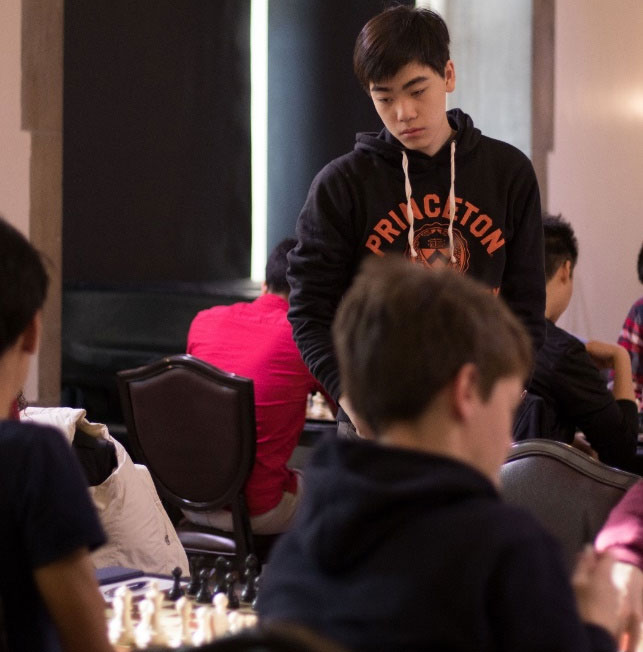
GM Andrew Tang on the prowl (get it?) | Skylar (Cheryl) Cheung
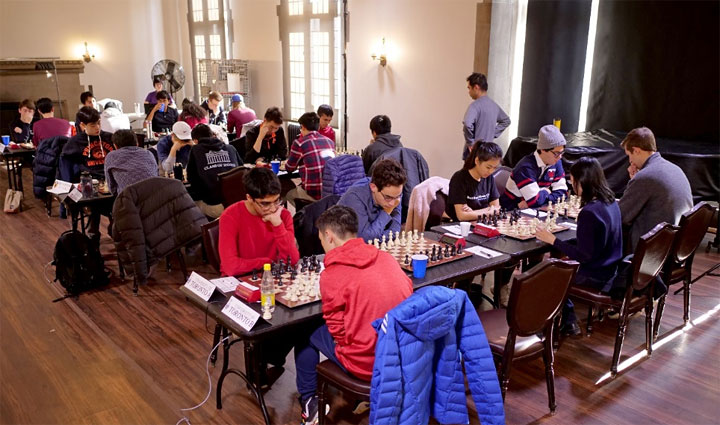
The 2nd Ivy League Chess Challenge is underway! | Panagiotis Tsialas

It’s always refreshing to see female players at chess tournaments!

The four girls participating (L to R): Sarah Ascherman (Harvard), Juntong Lin (University of Toronto B), Ella Papanek (Harvard), and your author, Qiyu Zhou (University of Toronto A) | Photo: Panagiotis Tsialas
University of Toronto A won against Yale, University of Toronto B won against Princeton, and Harvard lost to MIT.

Lots of exciting games were played throughout all the rounds, but the third round was extra special! The winner of the Best Game Award went to the following game, with annotations by FM Mark Plotkin (University of Toronto A).

[Event "2nd Ivy League Chess Challenge 2019"] [Site "?"] [Date "2019.11.09"] [Round "3"] [White "Li, Ethan"] [Black "Plotkin, Mark"] [Result "0-1"] [ECO "A25"] [Annotator "Mark Plotkin"] [PlyCount "92"] [EventDate "2019.??.??"] [SourceVersionDate "2019.11.10"] [WhiteTeam "Princeton"] [BlackTeam "University of Toronto A"] 1. d4 g6 {1...g6 is my usual response to anything. I'm not a big theory guy.} 2. Nf3 Bg7 3. c4 d6 4. e3 e5 5. Nc3 (5. dxe5 dxe5 6. Qxd8+ Kxd8 7. Nc3 c6 8. Be2 Kc7 $16) 5... Nc6 6. Be2 f5 7. d5 Nce7 8. Rb1 Nf6 9. b4 h6 10. Qa4+ Bd7 11. Qb3 O-O 12. O-O g5 13. c5 Ng6 14. Ba3 b6 {The goal is to slow down my opponents queenside attack. He is already quite ahead of me, and I wanted to stop him from going c6, with the idea of opening up the c-file.} 15. Bb5 { Trading light-squared bishops is usually bad for black, but in this case, I get a lot of tempos pushing my opponents pieces back.} Bxb5 16. Nxb5 g4 17. Nd2 a6 18. Nc3 b5 19. Bb2 Nh7 20. Ra1 $2 (20. a4 Rb8 21. axb5 axb5 22. Ra1 Qh4 23. Ra5 $16) 20... Qh4 21. a4 f4 22. Qc2 Rf6 23. Nde4 Rf5 24. g3 $2 {This move exposes the king too much. f3 was a better try.} Qh3 25. f3 gxf3 26. axb5 $4 { He had to focus on defending the king. After axb5, the game went quickly downhill for white despite my errors.} fxe3 27. bxa6 Ng5 28. Nxg5 hxg5 29. Ne4 g4 30. b5 Raf8 31. a7 f2+ 32. Nxf2 Rxf2 33. Rxf2 exf2+ 34. Qxf2 Rxf2 35. a8=Q+ Kh7 36. Kxf2 Qxh2+ 37. Kf1 Qxb2 38. b6 Qb5+ 39. Kg2 Qe2+ 40. Kh1 Qf3+ 41. Kh2 cxb6 42. cxd6 Qf2+ 43. Kh1 Nf4 44. Rg1 Nh3 45. Rg2 Qf1+ 46. Kh2 Ng5 {Crazy game from start to finish. This won the award for being the best game of the tournament. I feel very humbled for winning it considering that my opponent, Ethan Li put up a very strong fight. It seemed one-sided at first, where Ethan had me for the first 20 moves, but once I was able to get crazy play on the kingside with 26....fxe3 the game was completely out of control. This was definetly very fun, but also quite stressful.} 0-1
I believe the runner-up to the best game deserves a mention too. This wild tactical game was played between Altschuler Jason (MIT) and Webster Dex (Yale), with White coming on top in the end.

[Event "2nd Ivy League Chess Challenge"] [Site "?"] [Date "2019.11.07"] [Round "?"] [White "Altschuler, Jason"] [Black "Webster, Dex"] [Result "1-0"] [ECO "C00"] [Annotator "Altschuler Jason"] [PlyCount "71"] [EventDate "2019.??.??"] [SourceVersionDate "2019.11.10"] [WhiteTeam "MIT"] [BlackTeam "Yale"] 1. e4 c5 2. d3 {I was hungry before the round so food took preference over opening prep} e6 3. f4 d5 4. e5 Nc6 5. Nf3 d4 6. Be2 Nge7 7. O-O b6 (7... Nd5 8. c4) 8. Nbd2 Nd5 9. Ne4 Qc7 10. c4 dxc3 11. bxc3 Bb7 12. Ne1 {with the idea of Ne1-c2-a3-b5-d6, to exploit the fact that the queen is on the wrong square (c7 instead of d7). In hindsight, probably not the right idea though as it's quite slow} (12. c4 Ndb4 13. a3 Na6 $13 {kicking the knight away is also an option, but I wasn't sure since black seems to have easy play after castling long with ideas like f6/f5, Nd4, etc.}) 12... b5 13. Nc2 (13. c4 $1 {a nice idea we both missed, the idea being} bxc4 14. dxc4 Nb6 15. Nd6+ Bxd6 16. exd6 Qc8 {if Qd7, then the c5 pawn cannot be defended after Be3} 17. Be3 Nd7 18. Nd3 $16 {and the c5 pawn is under pressure}) 13... Be7 14. Qe1 O-O 15. Qg3 Kh8 ( 15... b4 16. c4 Nc3 $15 {followed by Nd4 is a nice idea for black}) 16. Bb2 c4 17. Kh1 Nb6 18. Rad1 Rad8 19. Ne3 Na5 (19... cxd3 20. Bxd3 Nxe5 $1 21. fxe5 Rxd3 22. Rxd3 Bxe4 23. Rd2 Bc5 $17 {with plenty of compensation}) 20. Ng4 f5 ( 20... Na4 $1 {a nice tactic we both missed} 21. Ba1 cxd3 22. Bxd3 Rxd3 $1 23. Qxd3 Qc6 24. Rfe1 Nc5 $19) 21. exf6 gxf6 22. Nh6 f5 $2 {the key error} (22... Na4 23. Ba1 cxd3 24. Bxd3 Nc4 $19) 23. Ng5 Bxg5 24. Qxg5 {playing this requires calculating that the knight on h6 cannot be trapped by Qg7 and Rf6, see the analysis below. There are some nice tactics that make this work.} (24. fxg5 {is also an option since the dark bishop becomes scary quickly} Qxg3 25. hxg3 Kg7 26. Ba3 Rfe8 27. Bh5 cxd3 28. Bxe8 Rxe8 29. Rxd3 $16) 24... Nd5 (24... Qg7 {I spent a long time making sure Qg7 and Rf6 didn't trap my knight. Ba3, dc, Bc5 works out for me -- see e.g., the following lines} 25. Ba3 $1 Rf6 26. dxc4 Rc8 (26... Re8 27. Bh5 Rc8 {just gives me an extra tempo}) 27. Bc5 $1 Naxc4 (27... Rxc5 28. Rd8+ Rf8 29. Rxf8+ Qxf8 30. Rd1 Rc8 31. Bh5 $1 {is mating }) 28. Bxc4 Nxc4 29. Bd4 e5 30. Bxe5 Nxe5 31. Qxg7+ Kxg7 32. fxe5 Bxg2+ 33. Kxg2 Rxh6 34. Rxf5 $11) 25. dxc4 bxc4 26. Ba3 Rg8 27. Rxd5 $1 {now the fun really begins (for me)} (27. Bd6 $1 {another killer shot}) 27... Bxd5 (27... Rxg5 28. Rxd8+ Qxd8 (28... Kg7 29. Rg8+ Kxh6 30. fxg5#) 29. Nf7+ Kg7 30. Nxd8 Bxg2+ 31. Kg1 Bxf1+ 32. Kxf1 {not only do I get two pieces for the rook, but also the knight on a5 is trapped!}) 28. Qf6+ Rg7 29. Bf3 Bxf3 30. gxf3 Rb8 31. Bf8 Qb7 32. Bxg7+ Qxg7 33. Qxe6 ({also easily winning is} 33. Nf7+ Kg8 34. Rg1) 33... Qxc3 34. Nf7+ Kg7 35. Rg1+ Kf8 36. Ne5 1-0


University of Toronto B team faces off against MIT! GM Parimarjan Negi, A PhD student in Computer Science, could have potentially been the MIT board one!| Photo: John Upper
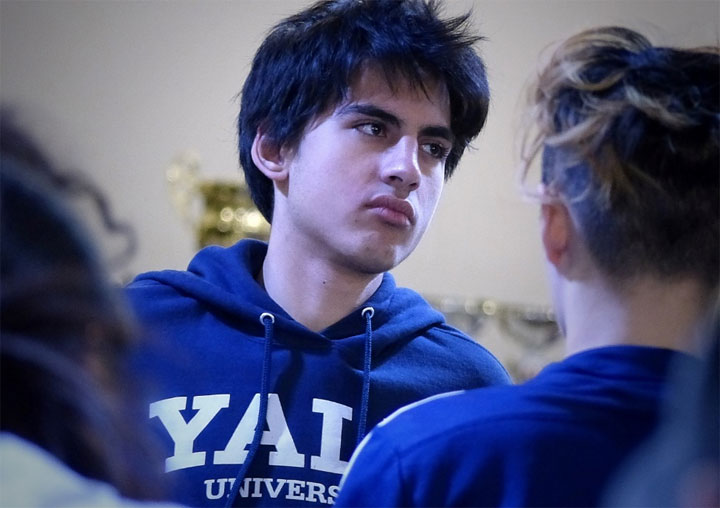
Nalin Khanna (Yale) is looking slightly unimpressed | Photo: John Upper

With University of Toronto A winning against MIT 2½:1½ in the penultimate round, University of Toronto A takes home the trophy in a clean fashion. Last year’s champions, Princeton, won against Harvard 3 to 1 to take second place.

MIT against University of Toronto A. University of Toronto A has not lost a single round so far! | Photo: Panagiotis Tsialas

Thus University of Toronto A took home the Ivy League trophy! In second place was Princeton, and in third place was MIT.

Individual best performance board prizes were given out too! University of Toronto A won on boards 2, 3, and 4.
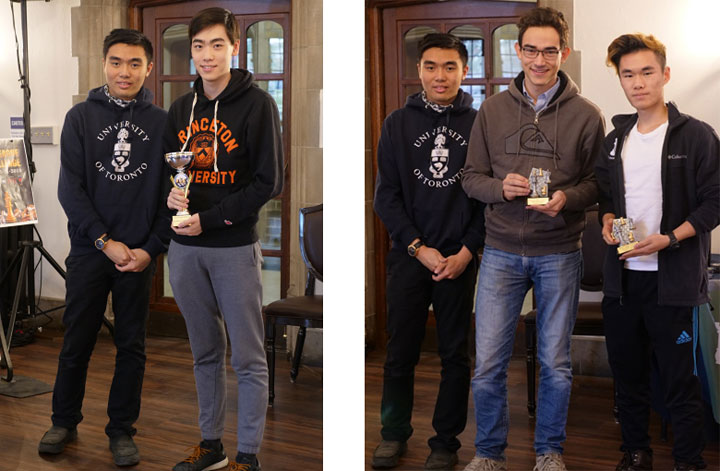
Best board 1 prize went to Andrew Tang (right) from Princeton! Best game award went to the third round (annotated above) between Ethan Li (Princeton) and Mark Plotkin (University of Toronto A) | Photo: Panagiotis Tsialas
A special word of thanks to the organizers Panagiotis Tsialas, Sean Lei, Alyssa Rusonik, Tanner McNamara, as well as the arbiters Weiwen Leung, Alex, Corinna Wan, Karen. All pictures from the tournament are available in a photo gallery.